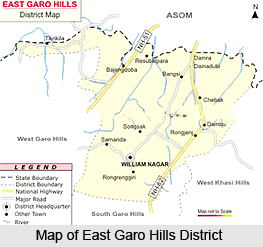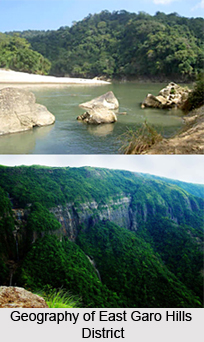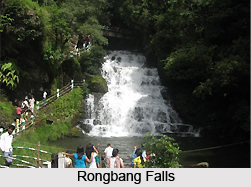 East Garo Hills District is an administrative district of Meghalaya. It was advanced from a sub-division to a separate district in 1976 after the erstwhile Garo Hills District was reorganized with a view to bring the administration closer to the people. East Garo Hills District is bounded by South Garo Hills on the south, by West Garo Hills on the west, by East Khasi Hills on the East and by Assam on the north. Williamnagar is the districts headquarters. The headquarter-complex is a neatly planned township. It has been christened as Williamnagar after the name of Captain Williamson A. Sangma, the first chief minister of Meghalaya. Williamnagar now has all the amenities of a modern town and is the largest growth centre in Garo Hills, next to Tura. East Garo Hills District occupies a total area of 2603 sq kms. This district lies between 25.24 degree north and 26.10 degree north latitude and 90 degree east and 91.3 degree east longitude.
East Garo Hills District is an administrative district of Meghalaya. It was advanced from a sub-division to a separate district in 1976 after the erstwhile Garo Hills District was reorganized with a view to bring the administration closer to the people. East Garo Hills District is bounded by South Garo Hills on the south, by West Garo Hills on the west, by East Khasi Hills on the East and by Assam on the north. Williamnagar is the districts headquarters. The headquarter-complex is a neatly planned township. It has been christened as Williamnagar after the name of Captain Williamson A. Sangma, the first chief minister of Meghalaya. Williamnagar now has all the amenities of a modern town and is the largest growth centre in Garo Hills, next to Tura. East Garo Hills District occupies a total area of 2603 sq kms. This district lies between 25.24 degree north and 26.10 degree north latitude and 90 degree east and 91.3 degree east longitude.
History of East Garo Hills District
History of East Garo Hills District is not very clear as it lacks concrete evidences. As per the early history of East Garo Hills District, Garo kingdom was established in the region. Modern history of this district suggests that the British rulers took over the charge of Garo kingdom when conflicts started between the Garo people and the Zamindars. Eventually, in the year 1979, Garo Hills District was bifurcated and East Garo Hills District was formed.
Geography of East Garo Hills District
Geography of East Garo Hills District is spread over hilly terrain. The hills are highly dissected and one major formation is the Arbella Range, which cuts through the south-central part of the district. The range consists of peaks with an average height of 700 metres above sea level. Another important physiographic feature is the Simsang Valley which runs through the southern part of the district.
 River Simsang is the longest river in Garo Hills, which originates in West Garo Hills and flows through East Garo Hills and South Garo Hills. The topography of the rest of the district is of undulating low hills, with altitude ranging from 150 to 600 metres above sea level, with plain fringes in the northern areas neighbouring Assam. Besides Simsang River, other rivers flowing through East Garo Hills District are Manda (Dudhnoi), Ildek, Didram and Damring (Krishnoi). Other than Simsang which drains south-eastwards, others run north or northwest towards the Brahmaputra River.
River Simsang is the longest river in Garo Hills, which originates in West Garo Hills and flows through East Garo Hills and South Garo Hills. The topography of the rest of the district is of undulating low hills, with altitude ranging from 150 to 600 metres above sea level, with plain fringes in the northern areas neighbouring Assam. Besides Simsang River, other rivers flowing through East Garo Hills District are Manda (Dudhnoi), Ildek, Didram and Damring (Krishnoi). Other than Simsang which drains south-eastwards, others run north or northwest towards the Brahmaputra River.
Demography of East Garo Hills District
As per Census 2001, total population of East Garo Hills District is 2,50,582. The population of this district consists of two major groups - tribal and non-tribal. The tribal population of the district amounts to near about 96.54 percent of the total population. The majority of the tribal populations are the Garos, while the other indigenous inhabitants are the Hajongs, Rabha Tribe, Koches, Rajbonshies, Kachari and Dalus. The small non-tribal population, including the Scheduled Castes is mostly concentrated in the urban settlements of Williamnagar and Resubelpara and the northern plain fringes of the district. The distribution of population in East Garo Hills District is uneven and is mostly governed by its topography. The population of the district is mainly concentrated on the northern fringe plain area. Since the economy of the district is primarily agricultural, the topography and soil type have a great influence on the population distribution. Also the uneven topography which also influences factors such as accessibility to the areas causes the low density of population in the interiors of the district.
Administration of East Garo Hills District
Administration of East Garo Hills District includes one Civil sub-division namely Resubelpara. Further, it includes five Community Development Blocks namely Dambo-Rongjeng, Kharkutta, Resubelpara, Samanda and Songsak. In East Garo Hills District there are 891 Revenue Villages. Administrative set-up of East Garo Hills District is headed by Deputy Commissioner.
Culture of East Garo Hills District
Garo tribe constitutes the majority in East Garo Hills District. The district is also inhabited by a sizeable population of Rabha Tribe, Hajongs, Koch Tribe, Dalus, Banais and Bodo tribe. The Garos are the second largest tribe after Khasi tribe in Meghalaya. The language of the Garos belongs to the Bodo branch of the Bodo-Naga-Kachin family of Sino Tibetan phylum. Since the Garos are scattered far and wide, and since these scattered units were in isolation from each other over time, they have developed their own separate identities and dialects. Still, features like their traditional political setup, social institutions, marriage systems, inheritance of properties, religion and beliefs are common between these groups. Moreover, these groups are endogamous generally. The Garos of East Garo Hills District practice slash-and-burn agriculture or jhum-cultivation.
Economy of East Garo Hills District
Economy of East Garo Hills District is agriculture based. Rice, maize and other important crops are cultivated here. People of this district are also engaged in animal husbandry, dairy farming, weaving, mining and sericulture. However, most of the people earn their living directly or indirectly through agriculture. Moreover, East Garo Hills District offers great scope for floriculture. Weaving is one of the most important vocations in the economic life of the Garos.
 Tourism in East Garo Hills District
Tourism in East Garo Hills District
East Garo Hills District offers several popular tourist attractions to the travellers visiting this place. It also includes visits to sites of historical importance. Ta`sek Lake, Rong`bang Falls, Domre Falls, Mokma Dare, Naphak or Napak, Nongchram, Rajasimla, Williamnagar, Darugiri, Dainadubi, Mendipathar, Resubelpara and Rongrenggiri are some of the major tourist attractions of East Garo Hills District. These places of the district are worth visiting.
East Garo Hills District has proper healthcare facilities as it has several Community Health Centres, Primary Health Centres, Dispensaries, Leprosy Societies and Tuberculosis Societies.






